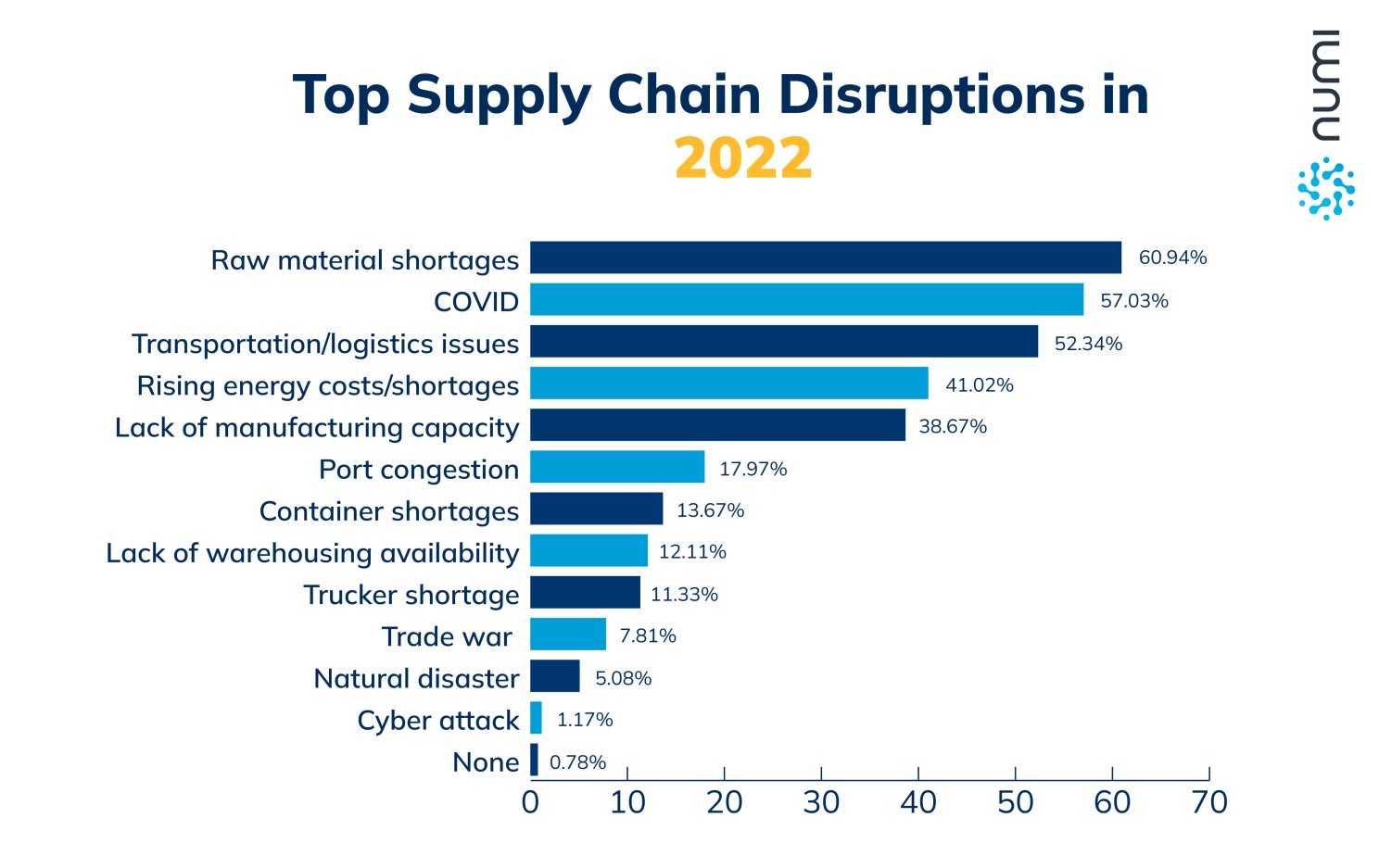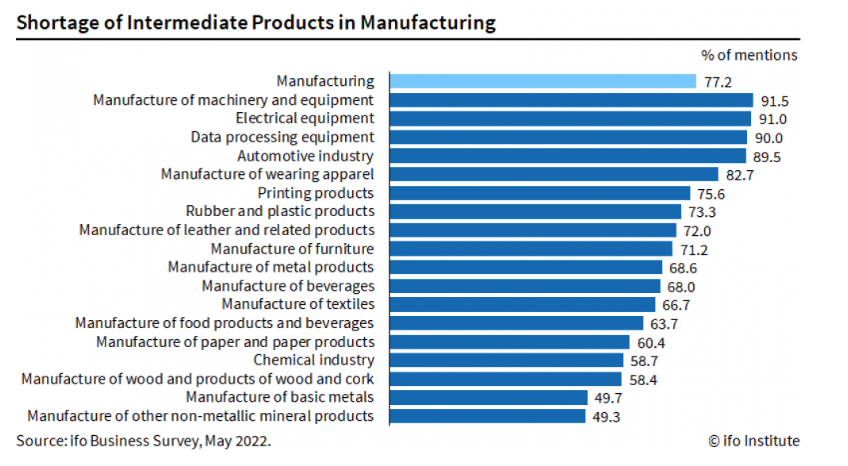
The Impact of Supply Chain Disruptions

Yulia Fedorova
26 Jan 2023
A look back on supply disruptions in 2022
In 2022 China closed businesses without discrimination. According to project44, Foxconn, a company that makes iPhones, was one of many crucial businesses in Shenzhen affected by supply chain disruptions. The factory was shut down by just 60 Covid cases, which resulted in a seven-day lockdown of the 17.5 million-person manufacturing metropolis. Yantian, home to one of the busiest container ports in the nation, was part of the one-week Shenzhen closure. Other densely inhabited areas of the city, such as the Futian and Nanshan commercial centers, were also shut down.
Another research from Interos indicated that in late March, almost 20,000 Tier-1 suppliers with headquarters in Shanghai were forced to close their doors to U.S. companies. According to Interos, the number increased to 95,000 when Tier-2 suppliers were considered and 203,500 at the Tier-3 level.
Import containers waited an average of 12.1 days during the two weeks from April 7 to 21, as stated in the project44 report. It increased 163% from the two weeks prior when average container wait times were 4.6 days. Shipments were transferred to river-based ports like Ningbo-Zhoushan due to the decreased throughput in Shanghai. According to Freightos, the backlog of reduced shipments had caused a 10% increase in rates between Europe and South America, with 30% of the backlog shipments coming from China.
The shipping index from E2open states that it took 76 days on average for containers to travel from Asia to Europe in the third quarter of 2022. Supply chain managers are falling asleep at the wheel without visibility, and the problems will continue to cause subpar performance and bare shelves. Firms can accurately foresee and prepare for supply shortages using artificial intelligence, real-time quality data, and a thorough grasp of lead time variance.
Most ship categories had less congestion in Chinese ports in 2022. However, there are still significant numbers of people waiting in line. Every week in 2022, at least 800 ships have been berthed in Chinese ports. Some weeks, that number has exceeded 1,000 ships, according to Breakwave Advisors.
One very business critical effect of these disruptions are rising in raw material prices, with the raw material shortage persisting at a constantly high level, according to the NAM's Q1 2022 Manufacturers' Outlook Survey. This has deepened a range of problems for companies in the paint and coatings industry, from increased shipping costs from Asia to the U.S. and longer lead times.
The shortage of materials in the industry was further made worse by the situation in China in the spring of 2022. Machine and equipment producers were severely hit, accounting for 91.5, and were closely followed by electrical and electronics firms. One in two businesses experiencing material shortages claimed that the Chinese lockdowns had made the situation worse than it had already been.

The impact on supply chains
The result of these unstable conditions and lead time increases have been faced by many European industrial companies and brands throughout the year and resulted in plenty of missing raw materials and components, as stated in the following chart.

The impact of raw material and component shortages on various supply chain KPIs is tremendous:
- Higher raw material & WIP inventories
- Longer production throughput times
- Inaccurate order confirmations and ATP dates
- Higher lost sales through stockouts
Many semi-finished goods are stored in local warehouses, or their production has yet to begin due to a crucial component being stuck in a container in China or unable to leave a Taiwanese chip factory. Consequently, inventory levels have risen significantly, particularly for raw materials and semi-finished goods.
Longer production lead times and lower machine utilization are other impacts of these supply disruptions. Furthermore, many production steps cannot be started as planned or need to be rescheduled due to the lack of parts, resulting in higher setup costs, more prolonged production throughput times, and decreased machine utilization.
Precise available-to-promise dates and quantities can only be confirmed accurately with a considerable investment of manual effort. Lead times in the ERP systems are predetermined and don't consider the variations in lead time for overseas shipments, making it even more challenging to accurately calculate available-to-promise dates and quantities.
In some cases, customers even cancel already placed orders, and lost sales through stockouts increased.
To overcome all these hurdles, a lot of effort, in most cases manual efforts, are required to bring the supply chain organization back on track. Daily firefighting meetings are set up where the impact of missing parts on raw materials, production orders, and customer orders are analyzed if possible. Unfortunately, most companies operate in intricate networks, making it almost impossible to detect the effects of supply-chain disruptions.
Where to focus in 2023
Resilience is the goal of any successful organization. The ability to anticipate and adapt to change is the cornerstone of success. Flexibility and maximum optionality are the keys to realizing this goal.
Rethinking supply chain networks
The COVID-19 pandemic has caused major supply chain disruptions across industries, leading many businesses to seek alternative sources of the materials they need. According to a Boston Consulting Group report, 60% of companies are accelerating preparations due to the pandemic to diversify their supply base and shift production outside China. This is often referred to as "second sourcing" or "sourcing resilience," and it ensures that companies have enough of the components they need to continue operations.
Having options is also at the top of the mind. Second or third sourcing is beneficial for companies because it allows them to quickly replace suppliers if their primary source runs into trouble or becomes unable to fulfill orders. It also helps to ensure that companies don't become too reliant on a single source, as having multiple suppliers can help reduce costs and provide better-quality materials. Second sourcing can help to diversify the supply chain and broaden a company's reach.
On the other hand, it can be costly and challenging, requiring a lot of research and due diligence. Companies must carefully evaluate potential suppliers to ensure they are reliable and capable of producing quality materials. Companies must also consider the cost of switching suppliers, as it can be expensive and time-consuming.
Also, closer supplier collaboration with critical suppliers is an important part of managing a successful supply chain during uncertain times. Companies can use collaborative approaches to ensure stable supply chains and available raw materials to continue operations.
The right supply chain technology
Companies can maximize their supply chain efficiency and responsiveness by enabling cross-team collaboration with the right technology and processes. Without the right technology in place, data silos created by traditional supply chain stakeholders can impede visibility, leading to missed shipments, unexpected delays, and promotional campaigns that don't align with inventory availability. By leveraging modern outside-in supply chain processes and technologies, companies have greater visibility into each step of the supply chain journey to ensure orders arrive on time, campaigns are correctly timed, and customers are provided with the best possible experience.
Traditional algorithms, which rely on historical data and static parameters, have been unable to keep up with the dynamic changes in supply and demand. This is because these algorithms are inherently limited in their capacity to anticipate dynamic changes in the market and adapt to them quickly.
Moreover, traditional algorithms are unable to handle the constantly changing nature of supply and demand, which is a major challenge for companies trying to stay competitive in the current environment. In particular, the dynamic nature of supply and demand requires companies to quickly adjust their supply chain processes, inventory levels, and pricing strategies to remain competitive. However, traditional algorithms cannot adequately account for such rapid changes, resulting in suboptimal outcomes.
In short, traditional supply chain algorithms are not well suited to the current environment. In order to stay competitive, companies must use algorithms that are more resilient to dynamic market conditions, equipped to handle real-world complexities, and able to incorporate risks into supply chain decision-making.